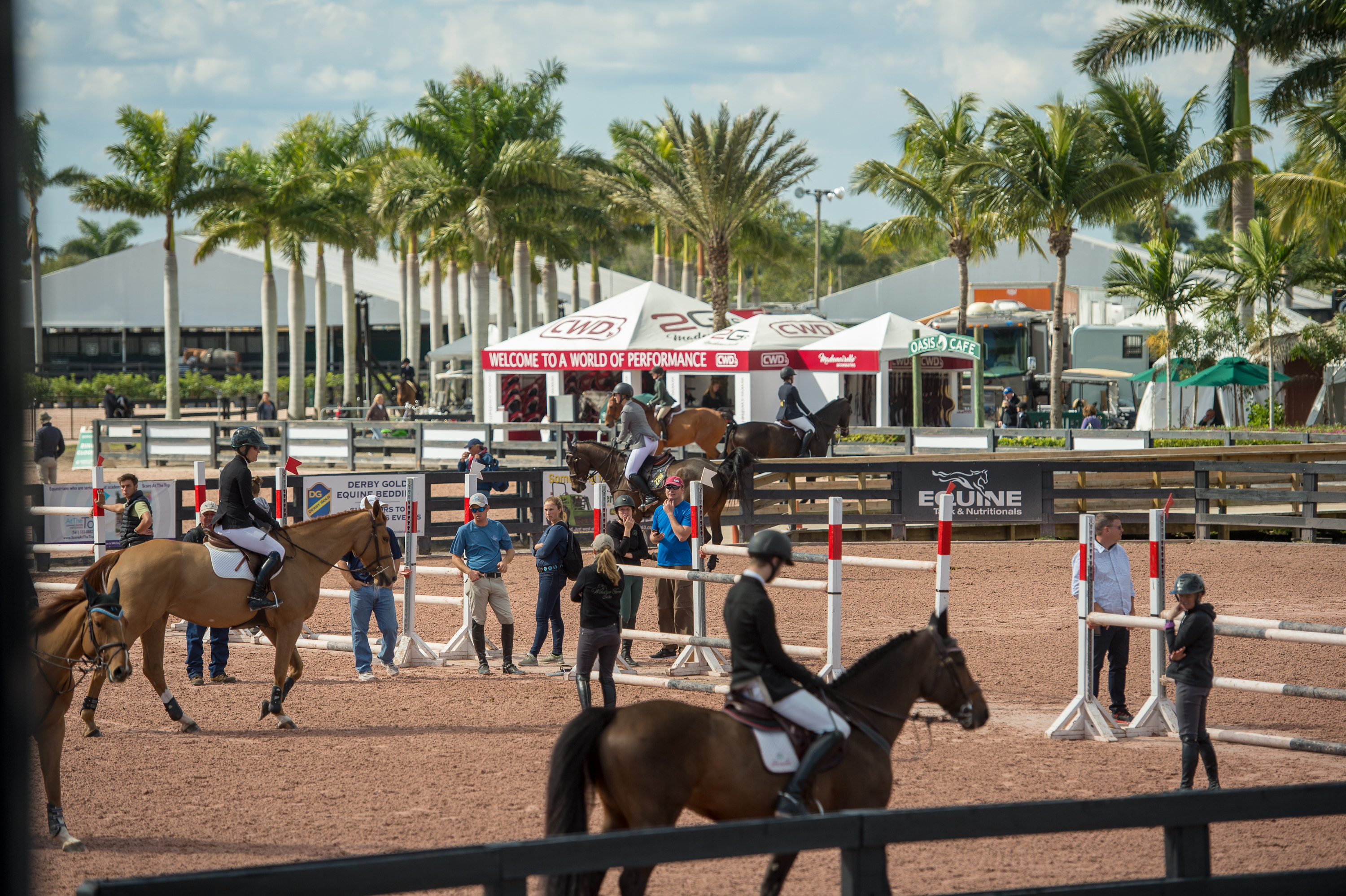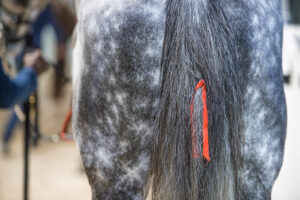The warm-up arena at a competition can be terrifying, if not downright dangerous. When helping my horses and students warm up for competition, I’ve seen riders circle right in front of a warm-up fence another rider was about to jump, just missing a collision. Other times, I’ve seen riders jumping fences set unsafely. Besides these near disasters, trainers and ground people sometimes demonstrate warm-up ring “habits” that can be frustrating to others trying to share the space—sitting on a warm-up fence so no one else can use it or leaving trash in the warm-up ring.

The warm-up arena doesn’t have to be a danger zone or such an aggravating place that you don’t want to be there. There are many well-known rules and some little-known ones in the United States Equestrian Federation Rule Book regarding proper procedures created to keep everyone—you, your trainer and ground people helping you—safe as you prepare your horse for competition or just hack him on a non-showing day. These rules apply to USEF-rated shows, though many unrated and schooling shows follow them as well to ensure safety. I’ll review some of the most basic and share some personal pet peeves that I often see or experience warming my horses and students up for competition.
Standard Rules and Practices
These are some commonly known and practiced rules, though I still see a surprising number of riders not adhering to them:
1. Always pass horses coming toward you so that your horse’s left shoulder and their left shoulders are on the same side, what is known as “left shoulder to left shoulder.”
2. To pass horses going in the same direction, always do so on the side facing the inside of the ring. Never pass by riding between a horse and the rail. It’s a good way to get kicked with no way to escape.
3. Horses heading toward a jump have the right-of-way, meaning you need to stay out of their way. To do this, you need to be aware of what others are doing and stay on the rail instead of circling in front of or behind the jumps. Most likely you’ll cut someone off on their approach to or departure from those jumps or cause a wreck. This is the exception to the rule “left shoulder to left shoulder.”
4. Avoid galloping from one warm-up arena to another. Sometimes, especially at bigger competitions, warm-up arenas are set up side by side. Galloping from one to the other to open up your horse’s stride or when trying to get a better approach to a jump is dangerous because other riders aren’t expecting the traffic pattern you are creating and, therefore, aren’t paying attention to you “entering” their arena this way. This is an accident waiting to happen.
5. A red ribbon in a horse’s tail means “this horse kicks,” so stay back.
6. If jumps have red and white flags at the top, you can only jump them in one direction with the red flag on the right and white flag on the left. When oxers are flagged, they cannot have a ground line on the landing side.
7. Oxers can be square or ascending, meaning the back rail is higher than the bottom, but never descending. Swedish oxers, a crossrail-type oxer in which one side of the front rail is lower than the other side and the opposite rail behind is lower, cannot be set in jumper schooling areas because it often results riders excessively schooling over the high side in front in an effort to get a rub and tune their horses up. However, Swedish oxers can be set in hunter schooling areas.
8. If Swedish oxers are set in the hunter schooling ring, there cannot be more than an 18-inch height difference from the highest and lowest parts. But stay tuned to the USEF Rule Book because this height difference might change in the future.
9. Horses and riders who are preparing for a class have priority over riders trying horses for sale or having lessons.
10. Once the jump is set at 4-foot-3 (1.3 meters), there must be a minimum of two rails in cups on the takeoff side. Fences must have tape marks (strips of tape put there by stewards) at 1 meter, alerting riders who are preparing for a young jumper class that another rail needs to be added at this point. This rule applies only for those schooling before young horse classes to help the horses judge the takeoff better by having an easier time seeing the depth. Additionally, the stewards must mark the standards at 5-foot-six (1.6 meters), which is the maximum height a jump can be set in the schooling ring.
Little-Known Rules
Some little-known and rarely abided by rules include:
1. If a horse has a red ribbon attached to his browband, it means he has an issue with another horse coming toward him. Be sure to give him plenty of room.
2. A landing rail or placing pole is a rail laid parallel to the jump, placed before or after the jump to shorten or lengthen a horse’s takeoff or landing stride. A guide rail is a pole laid perpendicular to the jump, either before or after the jump, to correct a crooked approach to or departure from the jump. If either is set on the approach to a jump, it may be no closer than 8-foot-2 (2.5 meters).
3. A landing rail must be set at least 9-foot-10 (3 meters) past the jump. This includes guide rails, as a horse could land on them and seriously injure himself.
4. Safety cups are jump cups that break away on impact. These must be supplied in all schooling areas for oxers and used. This is a rule for safety so if a horse doesn’t clear the back rail he won’t get tripped up and fall.

5. It is against the rules for someone to hold a rail or touch a standard while the horse is jumping it. This rule is in place to prevent someone from raising the rail as the horse jumps the fence and trying to rap his legs with it.
6. If an oxer is flagged to be jumped in only one direction, only one rail may be used on the back element, either parallel to or higher than the front rail. This is a safety rule because the fewer rails on the back side of an oxer, the safer it is, as it will knock down easier.
7. If you want to drape a blanket or cooler over a fence to make a warm-up fence look more impressive, it may be used on any of the rails (if there is more than one) on a vertical. It may be used only on the front side or front plane of an oxer—not over the top of the entire oxer or on the back rail, creating an optical illusion.
8. Effective Dec. 1, 2017, riders may not use earbuds while in the schooling area.
9. If you are jumping a liverpool, you may not set it behind the vertical plane of the front rail, whether used with a vertical or an oxer. It can be used under an oxer, however the liverpool’s edge must be directly under the front rail or farther forward. If you’re using it with an oxer, it may not be more than 3-foot-3 (1 meter) in front of the jump. The overall width of a liverpool can never exceed 5-foot-11 (1.8 meters).
Pet Peeves
Some of the following are habits that trainers and riders get into in the warm-up arena that aren’t very courteous to others around them. They include:
1. Setting jumps or moving poles to make landing rails, combinations or other configurations and not putting them back when you are finished.
2. “Holding” a jump by sitting on it or otherwise laying claim to it when there are more than six trips in front of you when there are limited schooling jumps.
3. Jumping dozens of jumps and/or giving a lesson in the warm-up ring while other riders need the jumps. This is not the intended use for the warm-up arena.
4. Hacking side by side with another rider (or more) or letting their horses saunter around while chatting with friends can make it difficult for other riders to safely get around them.
5. Having to listen to loud, obnoxious insults by trainers toward their students during schooling. Isn’t this the time to build confidence, not destroy it, before riders head into the arena to compete?
6. Leaving trash, including water bottles, coffee cups and other drink containers, next to warm-up jumps. Be considerate of the show staff and fellow riders and find an appropriate receptacle for your garbage.
7. Leaving a rake with the teeth facing up next to the outside of a jump standard where people or horses could step on it and potentially injure themselves. Instead, stand a rake against a standard with teeth facing in.
8. Dragging a liverpool around or throwing a cooler over a jump with little or no regard for how many horses you are scaring.
9. While waiting to use a jump, not helping the current person jumping it. It’s courteous to help build a jump in such situations, especially if the person is by him- or herself.
10. Not paying attention to other riders on horseback as you leave the warm-up arena, potentially cutting them off as you get to the out-gate. Also, it’s dangerous to be distracted by being on the phone or texting at any time in the schooling area.
11. Having too many unnecessary helpers in the warm-up ring not paying attention to other riders.
12. Arguing with the steward/schooling supervisor when told that a fence is illegal. Supervision of the warm-up arena is the responsibility of the stewards and/or schooling supervisors who are well-versed in the rules and regulations for everyone’s safety and well-being.
For complete rules and to stay current with new ones, visit www.usef.org. Under the “Compete” tab in the menu bar, click on the “Rules & Regulations” section to find the rule book for your discipline.
If everyone gives themselves a little refresher on the basic rules and studies some of the lesser-known ones, I think it will go a long way toward making the warm-up arena a better experience for everyone. Let’s all be safe, informed and courteous!
Watch & Learn on E+
From short training tips to how-to videos and insider-access to private clinics and lessons, learn from top hunter, jumper, eventing, equitation and dressage experts on EQUESTRIAN+.
About Julie Winkel
Owner of Maplewood Stables in Reno, Nevada, Julie Winkel has been a U.S. Equestrian Federation “R” hunter breeding, hunter and hunt seat equitation judge for 30 years. Julie was one of the first U.S. Hunter Jumper Association Certified Trainers and has trained and shown hunters and jumpers to the top level, nationally and internationally.
This article was originally published in the April 2018 issue of Practical Horseman.

